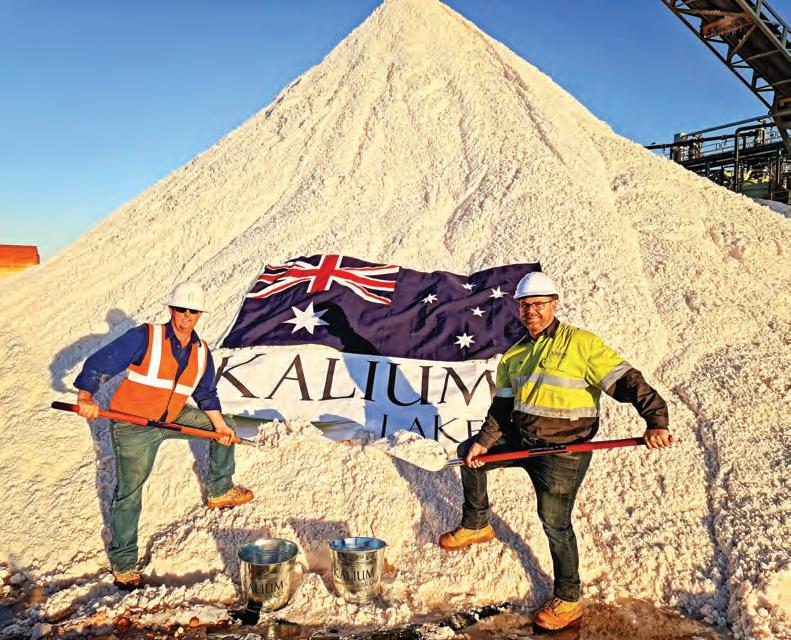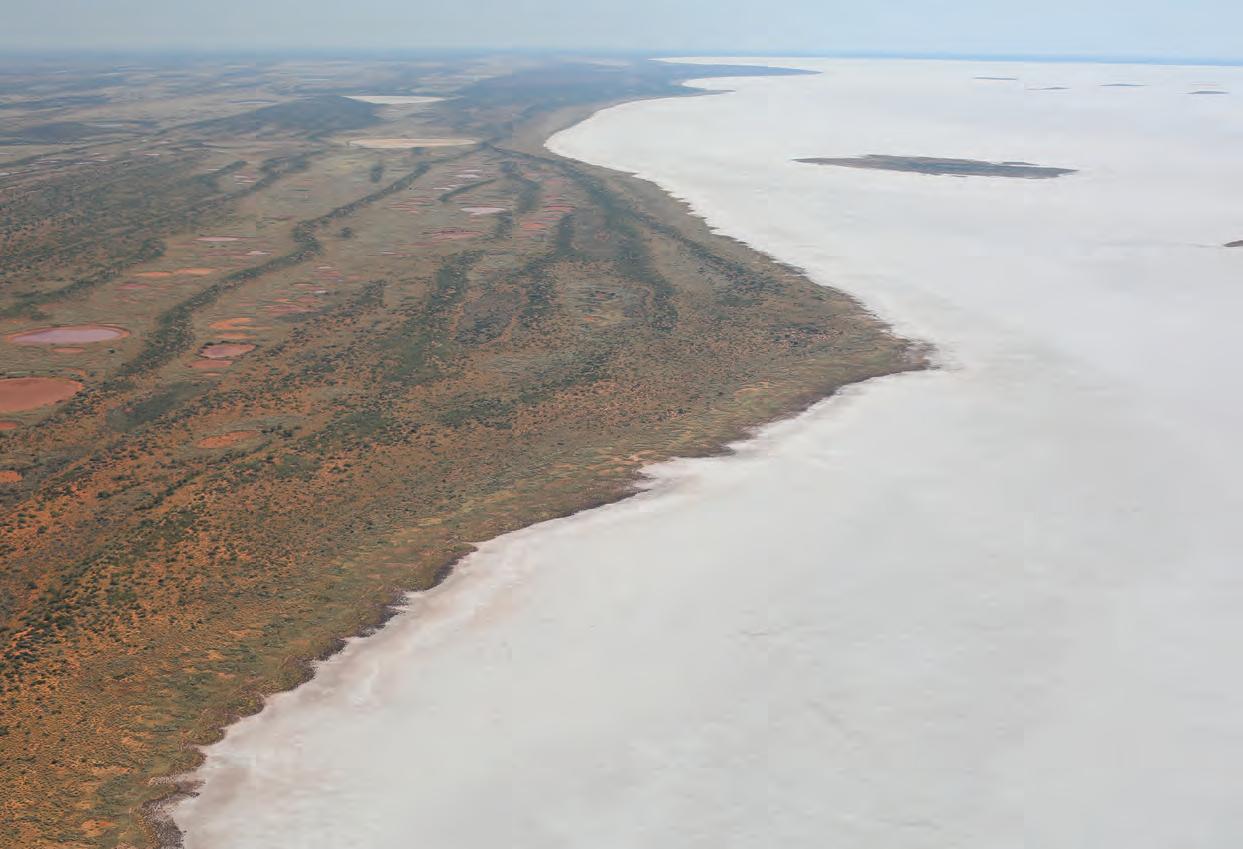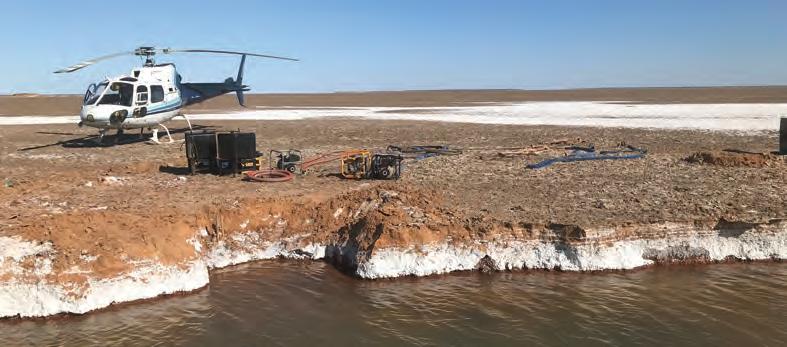
10 minute read
Australia’s emerging potash producers
AUSTRALIA SEEDS FIRST POTASH PRODUCTION
The Australian potash industry is on the verge of entering its maiden years of production across multiple sites thanks to a wave of rapidly developing projects in Western Australia.
Demand from the agricultural industry for an effective plant fertiliser boils down to one mineral: potash.
Potash is crucial for ensuring the pH level of soil is stable, which allows for more crops to grow – and with world populations increasing, more crops must be harvested for consumption.
In addition, mining companies must find more sustainable methods to extract a critical mineral such as potash.
The resource is currently mined and processed predominantly in countries like Canada and Russia using the Mannheim process. This is regarded by some as an inefficient way to produce potash as it converts muriate of potash (MOP) into sulphate of potash (SOP) by mixing it with sulphuric acid and heating it to 600 degrees.
However, in salt lakes such as what exist in Western Australia, SOP occurs naturally. There has been a push for domestic potash projects to come online over the past decade, with companies like Australian Potash, Kalium Lakes and Agrimin ramping up developments.
The flagship projects from all three companies are aiming to produce – or have already produced – SOP.
Australia’s first wave of potash developments can be traced back to 2013 when Geoscience Australia’s identified a series of potential potash deposits from salt lakes across the country as part of its Mineral Systems of Australia project.
The aspiring Australian developers are aiming to extract potash from brine in salt lakes rather than using the Mannheim process to enable a lower carbon footprint.
By introducing a domestic supply of potash, Australia will be self-sufficient in providing locally extracted potash for its agricultural industry.
Kalium Lakes took the baton as the first-ever mining company in Australia to produce SOP in October.
The SOP product was produced at the Beyondie project in Western Australia. Despite the recency of the milestone, the company is already looking at expansion, raising $50 million in October to boost its annual production from 90,000 tonnes per annum (tpa) to 120,000tpa.
“It sets us up now from being a project developer to producer,” Kalium Lakes chief executive officer Rudolph van Niekerk tells Australian Resources & Investment.
“It’s been seven hard years of working towards something new that’s never been done in Australia.”
Kalium Lakes was founded in September 2014 after the company formulated plans following the release of Geoscience Australia’s report.
Within years, the company had taken its first steps in moving Beyondie towards production, establishing a 50-year mine life at the project site.
The project comprises 16 exploration licences and two mining leases across 1800 square kilometres, and unlike the Mannheim method, Kalium produces SOP using an evaporation and processing method after sub-surface brine is extracted through trenching and bores.
According to van Niekerk, this puts Kalium Lakes ahead of overseas producers in terms of cost benefits and quality.
“I think primary producers of potash have a major advantage over the Mannheim
Kalium Lakes celebrating its milestone of reaching production.
Kalium Lakes achieved first production in October this year.

producers,” van Niekerk says. “The cost of Mannheim SOP production is significantly more expensive.
“Many of the Mannehim facilities that operate globally operate at zero to 50 per cent capacity because they cannot compete with primary SOP producers.
“It does become a question of supply and demand, but it really comes down to the cost of producing SOP – and we are producing at a substantial cost benefit compared to Mannheim producers.”
Australian potash producers are also in a strong position given the forecast 2022 average standard grade SOP price is $US617 ($846.47) per tonne.
The European Union, United States and Canada have enforced potash sanctions on Belarus, which is one of the world’s major producers of MOP. These sanctions are impacting about 15 per cent of Belarus’ exports.
Van Niekerk says this puts Kalium Lakes in a position to help meet the shortage of supply overseas.
“Very healthy crops in Australia are resulting in a large demand from Australian farmers and also farmers in other regions,” van Niekerk says.
“They have to replace those nutrients taken out of the soil, which is putting huge demands on fertiliser.”
The capital raising to increase Beyondie’s output also falls in line with a potash deficit that van Niekerk is anticipating from 2025 and beyond.
“From 2025 onwards, global demand in growth in SOP exceeds your supply capacity and you see that continuous upward trend in pricing,” van Niekerk says.
“What that means for us and other players is between now and 2025 we can not only expand production to 120,000tpa, but we can also look at expansion in excess of this and it could potentially offer opportunity for other producers to enter the market.”
In 2018, Kalium Lakes secured a 10-year offtake agreement with German potash company K+S, which supplies more than 50 per cent of Australia’s market.
This agreement will allow Kalium Lakes to also tap into a steady stream of local potash demand.
“From a Kalium Lakes point of view, it is a great time for us to achieve first production and the right timing to be there for the Australian market in particular,” van Niekerk says.
Australian Potash is another local potash project developer that is rapidly moving towards joining Kalium Lakes as an Australian producer.
The company is set to include a 35-megawatt renewable microgrid for its Lake Wells SOP project in Western Australia, which further adds to the greener approach of Australian produced SOP.
“We see the wave of investment into environmental, social and governance (ESG) aligned companies and ESG aligned investment opportunities as being like a tsunami,” Australian Potash managing director and chief executive officer Matt Shackleton says.
“We don’t think it’s a little thing, we think we’re going to be swamped with it (ESG) and we’re preparing for that outcome – it’s a short-term outcome.”
Lake Wells is 100 per cent developed and the site contains the largest measured
resource of potash in Australia.
Rather than relying on trenching, Australian Potash uses a bore-field drilling technique to extract potash, further driving the company’s ESG strategy.
This method allows potash to be transported to evaporation ponds that use the sun to produce potash.
Australian Potash is on the verge of receiving organic certification for its product in Australia (at the time of writing) after already receiving the certification in the United States and Europe.
“The reason we’re focussing on our environmental, social and governance strategy so intently is our customers are telling us that the jurisdictions they work in are already mandating they have to report the carbon chain through the supply chain,” Shackleton says.
“If you were to supply a tonne of SOP fertiliser into Europe, the day is imminent where the regulatory authorities are going to request that you are able if asked to provide a thorough supply chain carbon footprint starting January 2022.”
Lake Wells is located 500 kilometres northeast of Kalgoorlie in the Goldfields region of Western Australia.
The project has established a 30-year mine life and is targeting 170,000tpa from its resource, which comprises 18.1 million tonnes of SOP.
Australian Potash aims to deliver a final investment decision by December or potentially early next year, with the project expected to cost around $300 million to be constructed.
Shackleton says the aftershocks of COVID-19’s first wave has shown the importance of self-sufficiency and agrees the local agricultural market needs a local supply source.
“If COVID has done one thing, you do need to be able to be prepared to be self-sufficient of your domestic food production,” Shackleton says.
“You can only do that if you have

Agrimin is developing the Mackay potash project in WA.
domestic fertiliser supply or secure fertiliser supply. A lot of us read the Geoscience Australia (report) and went looking for potash – some of us found it.”
Potash is also proving to be an important future commodity for the blue-chip mining companies.
BHP approved a $US5.7 billion ($7.8 billion) investment to fund development of the Jansen stage one potash project in Canada this year.
The company also expects potash to increase in demand in the late 2020s, a promising forecast for BHP with Jansen designed to operate for up to 100 years.
“Potash provides BHP with increased leverage to key global mega-trends, including rising population, changing diets, decarbonisation and improving environmental stewardship,” BHP chief executive officer Mike Henry explains.
In its latest commodity outlook released in the September quarter, BHP noted that a recovery in potash prices in the second half of

Lake Mackay’s shallow water table allows for simple extraction of potash.
Agrimin aims to become the world’s lowest cost SOP producer.
2020 had gathered pace in calendar 2021, with a dramatic acceleration emerging in June.
BHP attributes the rise in prices to a combination of tight product availability and buoyant farm economics on the back of booming crop prices.
“With robust demand again in calendar 2021, inventories being lean and little succour as yet from expected greenfield start-ups in Belarus and Russia, the industry has been struggling to meet demand from their active capacity,” the outlook states.
Longer–term, BHP views potash as a future-facing commodity with attractive fundamentals.
“Demand for potash stands to benefit from the intersection of a number of global megatrends: rising population, changing diets and the need for the sustainable intensification of agriculture,” the company adds in the commodity outlook.
BHP is developing Jansen to produce 4.35 million tonnes of potash per year. The company plans to produce MOP from Jansen, which is less organic than the SOP products being developed in Western Australia.
This adds another benefit for local SOP production for the ‘green’ attributes if offers throughout the supply chain.
Agrimin, which is developing the Mackay potash project in Western Australia, has noted that the global agricultural industry is looking for alternative sources of SOP.
“The majority of SOP produced through the Mannheim process has environmental issues that are becoming more recognised by small farmers and customers that buy SOP,” Agrimin chief executive officer Mark Savich says.
Agrimin will target a global base of customers with one third of Mackay’s potash production going to China and the remaining two thirds spread across the Americas and Europe.
The company aims to become the world’s lowest cost SOP producer with the project based on Lake Mackay, the world’s largest undeveloped SOP brine deposit, containing 123 million tonnes of SOP.
Mackay’s net present value using an eight per cent discount rate is $US655 million and has an initial rate of return of 21 per cent.
After securing an offtake agreement with major Chinese importer Sinochem Fertilizer Macao (Sino), Savich says overseas customers are looking at Australia’s upcoming SOP industry with a keen eye.
“When we were talking to Sino, we were trying to understand why they were interested in importing SOP from Australia,” he says.
“It was very clear that they were looking to source organic environmentally friendly SOP for use in China to customers who value those ESG credentials, and they were happy to export their poorer quality SOP to a variety of countries.
“It just shows a market such as China is still placing huge importance on the organic credentials of fertiliser and they understand how important it is to maintain good soil balance to farm for generations to come, so I think that awareness is going to grow throughout more developing countries as food security issues emerge.”
Lake Mackay’s shallow water table allows for simple extraction through a trenching process before being transferred to evaporation ponds.
From Agrimin’s point of view, this is a low-risk approach combined with the company’s integrated logistics solution across a 940-kilometre stretch between Lake Mackay and the Port of Wyndham.
Agrimin plans to begin developing Mackay next year after receiving lead agency status from the Western Australian Government’s Department of Jobs, Tourism, Science and Innovation.
“The critical path item for us is the environmental approvals and we’re hoping to have those full approvals in place by the middle of next year and that would then allow us to move forward in the development of the project,” Savich says.
The economic benefits of Australian SOP production may be yet to materialise, but the supply chain advantages presented in the full gamut of Western Australian potash projects is set to give a positive shake-up to global supply.
And thanks to the low-emission methods of extraction, Australia is well-positioned to serve the domestic and international agricultural potash industries for decades to come.











